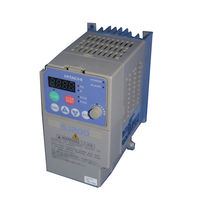User Manuals: Hitachi SJ200-055HFEF Inverter Drive
Manuals and User Guides for Hitachi SJ200-055HFEF Inverter Drive. We have 2 Hitachi SJ200-055HFEF Inverter Drive manuals available for free PDF download: Instruction Manual
Hitachi SJ200-055HFEF Instruction Manual (277 pages)
Single-phase Input 200V Class; Three-phase Input 200V Class; Three-phase Input 400V Class
Table of Contents
-
-
-
Revisions18
-
-
-
Introduction20
-
-
Introduction21
-
-
-
-
Powerup Test61
-
-
-
-
Voltage Gain89
-
PID Control94
-
Accel/Decel98
-
ADD Frequency101
-
-
Introduction129
-
-
Jogging Command142
-
Set Second Motor144
-
Free-Run Stop146
-
External Trip147
-
Software Lock149
-
Reset Inverter151
-
-
Run Signal164
-
Alarm Signal169
-
-
-
Troubleshooting191
-
-
Megger Test200
-
Spare Parts201
-
IGBT Test Method205
-
Warranty206
-
Warranty Terms206
-
-
Host Computer216
-
In this Appendix216
-
Introduction216
-
Modbus Network216
-
Cable Wiring217
-
-
-
Data221
-
Error Check221
-
Function Code221
-
Normal Response222
-
Write in Coil226
-
Loopback Test228
-
Write in Coils229
-
Modbus Coil List233
-
-
Index
271
Advertisement
Hitachi SJ200-055HFEF Instruction Manual (278 pages)
Table of Contents
-
Revisions19
-
Introduction21
-
Powerup Test62
-
PID Control95
-
Introduction130
-
Jogging Command143
-
Set Second Motor145
-
Free-Run Stop147
-
External Trip148
-
Software Lock150
-
Reset Inverter152
-
Run Signal165
-
Alarm Signal170
-
-
Dynamic Braking190
-
Troubleshooting192
-
Troubleshooting193
-
Error Codes196
-
Megger Test201
-
Spare Parts202
-
IGBT Test Method206
-
Warranty207
-
Warranty Terms207
-
-
Glossary208
-
Thermal Switch214
-
Introduction217
-
Modbus Coil List234
-
Advertisement

